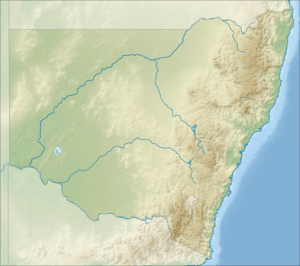Ferndale Park
| Ferndale Park New South Wales | |
|---|---|
|
"Old Man's Cave" and Swaines Creek | |
 Ferndale Park | |
| Coordinates | 33°47′58.6″S 151°10′09.89″E / 33.799611°S 151.1694139°ECoordinates: 33°47′58.6″S 151°10′09.89″E / 33.799611°S 151.1694139°E |
| Website | Ferndale Park |
Ferndale Park is located in suburban Chatswood West, 8 km (5 mi) from the centre of Sydney, Australia. It is an important[1][2] urban forest reserve, preserving Blackbutt forest and the mossy gully rainforest.[3] Most of this original forest was cleared for agriculture and housing in the 19th and 20th century.
Geography
Average annual rainfall is 1,200 mm (47 in) at the nearby Chatswood Bowling Club.[4] Soils are moderately fertile, based on Hawkesbury sandstone and Ashfield Shale.[5] Most of the reserve is considered part of the Sydney Sandstone Gully Forest.
History
The local indigenous Australian people, the Cammeraygal occupied this area for at least 5,800 years.[6] They were known to shelter in "Old Man's Cave" in heatwaves or heavy rain.[7]
Recreation
Ferndale Park has a series of walking tracks. Office workers from Chatswood may be seen jogging through the reserve at lunchtime.[8]
Flora
Noteworthy indigenous flora includes the blackbutt,[3] tree heath, celery wood, coachwood, native crabapple and hard corkwood. An impressive number of fern species grow here,[3][9] including jungle brake, fishbone water fern, filmy fern, Japanese lady fern, delicate rock fern and the necklace fern. In early winter, waxcap mushroom species in the Hygrophoraceae may be seen.[10]
Fauna
Ring-tail possums, brushtail possums and grey-headed flying foxes are common. Birds such as rainbow lorikeets, Australian king parrots, crimson rosellas, currawongs, koel, tawny frogmouth, pacific baza[11] and powerful owl[12] are some of the many found in the park. Microbats are present, including Gould's wattled bat, Lesser long-eared bat and the Little Forest Bat.[3] Many species of spider and other invertebrates live in the reserve. The Emerald Spotted Frog is known to occur.[13] An important remnant marsupial is the sugar glider.[14]
Bush regeneration
Forest conservation work is in progress. The weeds trad and privet being particularly troublesome. The shady areas form excellent habitats for fungi and rainforest plants, but disturbed areas are suited to invasive weeds.[14]
References
| Wikimedia Commons has media related to Ferndale Park. |
- ↑ A detailed fauna study completed in 2001 by Dr Arthur White of Biosphere Consultancy
- ↑ "LANE COVE RIVER CATCHMENT MANAGEMENT COMMITTEE Bushland Inventory". November 1998. Retrieved 9 October 2015.
- 1 2 3 4 "Sustainability/nature/bushland/Bushwalks/Tracks". Bushwalking Tracks. City of Willoughby. Retrieved 10 October 2015.
- ↑ http://www.bom.gov.au/ Chatswood Bowling Club Weather Station
- ↑ NSW Government Geological Series Sheet 9130 Edition 1, 1983
- ↑ Fact Sheet 8 – Chatswood West – Willoughby City Council
- ↑ City of Willoughby information sign
- ↑ Wild Walks – Ferndale Park Wild Walks – Ferndale Park
- ↑ "Birds Nest Fern". Flickr. Retrieved 10 October 2015.
- ↑ North Shore Times, 26 June 2015 page 23
- ↑ Wildlife Willougby Facebook Page (Willoughby City Council) 12 September 2015
- ↑ Wildlife Willougby Facebook Page (Willoughby City Council) 5 October 2015
- ↑ North Shore Times, 17 July 2015 page 21
- 1 2 Ferndale Walking Track pamphlet, City of Willoughby